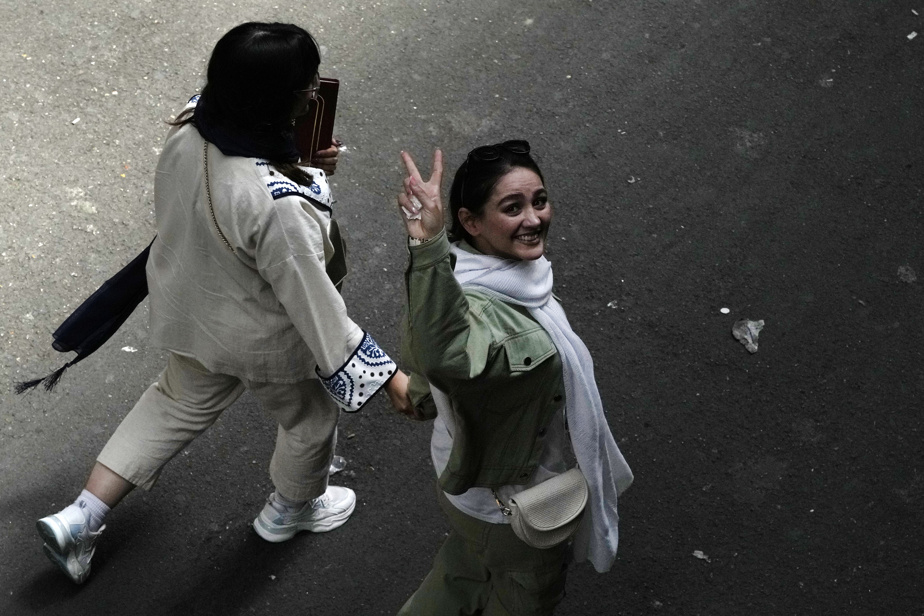(Dubai) On the streets of Iranian cities, it is increasingly common to see a woman walking past without the mandatory veil, or hijab, as the second anniversary of Mahsa Amini’s death and the mass protests it sparked approaches.
No government officials or studies acknowledge the phenomenon, which began when Iran entered its hot summer months and power outages became common. But on social media, videos of people filming the streets of their neighborhoods or simply talking about a normal day in their lives show women and girls walking with their long hair over their shoulders, especially after sunset.
This defiance comes despite what United Nations investigators describe as “extensive repressive measures and policies” by the Iranian theocracy to punish them – although no recent catalyzing event like Mahsa Amini’s death has galvanized the protesters.

PHOTO HUSSEIN FALEH, AGENCE FRANCE-PRESSE
Iran’s new president, Masoud Pezeshkian
The country’s new reformist president, Masoud Pezeshkian, campaigned on a promise to end harassment of women by morality police. But the country’s ultimate authority remains Supreme Leader Ayatollah Ali Khamenei, 85, who has said in the past that “unveiling is both religiously and politically forbidden.”
For some practicing Muslim women, the veil is a sign of piety before God and modesty before men outside their family. In Iran, the hijab – and the ubiquitous black chador worn by some – has also long been a political symbol.

PHOTO VAHID SALEMI, ASSOCIATED PRESS ARCHIVES
A woman defies the mandatory veil directive in Tehran.
“Meaningful institutional changes and accountability for gross human rights violations and crimes under international law, as well as crimes against humanity, remain elusive for victims and survivors, particularly women and children,” a United Nations (UN) fact-finding mission to Iran warned on Friday.
Mahsa Amini, 22, died on September 16, 2022 in a hospital after she was arrested by the country’s morality police for not wearing her hijab to the authorities’ liking. The protests that followed M’s deathme Amini began by chanting “Women, life, freedom.” But the protesters’ cries quickly turned into calls for revolt against Ali Khamenei.
A months-long security crackdown left more than 500 dead and over 22,000 arrested.

PHOTO VAHID SALEMI, ASSOCIATED PRESS ARCHIVES
A woman stares into a camera lens without a veil in Tehran.
Today, passers-by on the streets of Tehran, whether in the affluent northern suburbs for the rich or in the working-class neighborhoods of the south of the capital, regularly see women without hijabs. This begins especially at dusk, although even during the day, on weekends, women with uncovered hair can be seen in large parks.
Online videos – particularly those showing guided tours of the city’s streets for people living in rural areas or abroad who want to see life in Tehran’s bustling neighborhoods – include women without hijabs.
What would have stopped a person in their tracks in the decades following the 1979 Islamic Revolution is no longer recognised.
“My near-courage of not wearing a veil is a legacy of Mahsa Amini and we must protect this as an achievement,” said a 25-year-old student at Tehran’s Sharif University, who gave only her first name Azadeh for fear of reprisals. “She could be my age right now if she had not died.”
Disobedience always carries risks. Months after the protests stopped, Iran’s morality police are back on the streets.
Since then, scattered videos have emerged showing women and girls being manhandled by police officers. In 2023, an Iranian teenager was injured in a mysterious incident on the Tehran subway while not wearing a hijab; she died in hospital. In July, activists said police opened fire on a woman fleeing a checkpoint to avoid having her car seized because she was not wearing a hijab.
Meanwhile, the government has targeted private businesses where women are seen without veils. Surveillance cameras search for unveiled women in vehicles to fine them and seize their cars. The UN reported that the government went so far as to use aerial drones to monitor the Tehran International Book Fair and Kish Island in 2024 to spot unveiled women.
Yet some believe that the election of Masoud Pezeshkian in July, after a helicopter crash that killed Iranian President Ebrahim Raisi in May, is helping to ease tensions over the hijab.
“The current peaceful environment is part of the status after Masoud Pezeshkian came to power,” said Hamid Zarrinjouei, a 38-year-old bookseller. “In a way, Masoud Pezeshkian could convince powerful people that more restrictions do not necessarily make women more faithful to the hijab.”
On Wednesday, Iranian Attorney General Mohammad Movahedi Azad warned security forces against starting physical altercations over the hijab.
“We have pursued the offenders and we will continue to pursue them,” Mr. Movahedi Azad said, according to Iranian media. “No one has the right to have an inappropriate attitude even if an individual commits an offense.”
While the government has not directly addressed the growing number of women not wearing the hijab, there are other signs that it recognizes that the political landscape has changed. In August, authorities fired a university professor a day after he appeared on state television and disparagingly called Mme Amini of “dead”.
Meanwhile, the Ham Mihan newspaper, which preceded the reform, reported in August on an unpublished survey conducted under the supervision of Iran’s Ministry of Culture and Islamic Guidance, which found that the hijab had become one of the country’s most important issues, something that had never been the case before.
“This problem is more present than ever in people’s minds,” sociologist Simin Kazemi told the newspaper.
